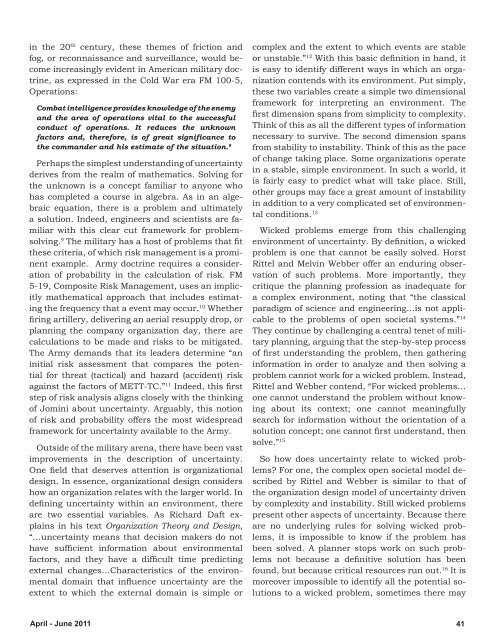George w. casey jr. - Federation of American Scientists
George w. casey jr. - Federation of American Scientists
George w. casey jr. - Federation of American Scientists
You also want an ePaper? Increase the reach of your titles
YUMPU automatically turns print PDFs into web optimized ePapers that Google loves.
in the 20 th century, these themes <strong>of</strong> friction and<br />
fog, or reconnaissance and surveillance, would become<br />
increasingly evident in <strong>American</strong> military doctrine,<br />
as expressed in the Cold War era FM 100-5,<br />
Operations:<br />
Combat intelligence provides knowledge <strong>of</strong> the enemy<br />
and the area <strong>of</strong> operations vital to the successful<br />
conduct <strong>of</strong> operations. It reduces the unknown<br />
factors and, therefore, is <strong>of</strong> great significance to<br />
the commander and his estimate <strong>of</strong> the situation. 8<br />
Perhaps the simplest understanding <strong>of</strong> uncertainty<br />
derives from the realm <strong>of</strong> mathematics. Solving for<br />
the unknown is a concept familiar to anyone who<br />
has completed a course in algebra. As in an algebraic<br />
equation, there is a problem and ultimately<br />
a solution. Indeed, engineers and scientists are familiar<br />
with this clear cut framework for problemsolving.<br />
9 The military has a host <strong>of</strong> problems that fit<br />
these criteria, <strong>of</strong> which risk management is a prominent<br />
example. Army doctrine requires a consideration<br />
<strong>of</strong> probability in the calculation <strong>of</strong> risk. FM<br />
5-19, Composite Risk Management, uses an implicitly<br />
mathematical approach that includes estimating<br />
the frequency that a event may occur. 10 Whether<br />
firing artillery, delivering an aerial resupply drop, or<br />
planning the company organization day, there are<br />
calculations to be made and risks to be mitigated.<br />
The Army demands that its leaders determine “an<br />
initial risk assessment that compares the potential<br />
for threat (tactical) and hazard (accident) risk<br />
against the factors <strong>of</strong> METT-TC.” 11 Indeed, this first<br />
step <strong>of</strong> risk analysis aligns closely with the thinking<br />
<strong>of</strong> Jomini about uncertainty. Arguably, this notion<br />
<strong>of</strong> risk and probability <strong>of</strong>fers the most widespread<br />
framework for uncertainty available to the Army.<br />
Outside <strong>of</strong> the military arena, there have been vast<br />
improvements in the description <strong>of</strong> uncertainty.<br />
One field that deserves attention is organizational<br />
design. In essence, organizational design considers<br />
how an organization relates with the larger world. In<br />
defining uncertainty within an environment, there<br />
are two essential variables. As Richard Daft explains<br />
in his text Organization Theory and Design,<br />
“…uncertainty means that decision makers do not<br />
have sufficient information about environmental<br />
factors, and they have a difficult time predicting<br />
external changes…Characteristics <strong>of</strong> the environmental<br />
domain that influence uncertainty are the<br />
extent to which the external domain is simple or<br />
complex and the extent to which events are stable<br />
or unstable.” 12 With this basic definition in hand, it<br />
is easy to identify different ways in which an organization<br />
contends with its environment. Put simply,<br />
these two variables create a simple two dimensional<br />
framework for interpreting an environment. The<br />
first dimension spans from simplicity to complexity.<br />
Think <strong>of</strong> this as all the different types <strong>of</strong> information<br />
necessary to survive. The second dimension spans<br />
from stability to instability. Think <strong>of</strong> this as the pace<br />
<strong>of</strong> change taking place. Some organizations operate<br />
in a stable, simple environment. In such a world, it<br />
is fairly easy to predict what will take place. Still,<br />
other groups may face a great amount <strong>of</strong> instability<br />
in addition to a very complicated set <strong>of</strong> environmental<br />
conditions. 13<br />
Wicked problems emerge from this challenging<br />
environment <strong>of</strong> uncertainty. By definition, a wicked<br />
problem is one that cannot be easily solved. Horst<br />
Rittel and Melvin Webber <strong>of</strong>fer an enduring observation<br />
<strong>of</strong> such problems. More importantly, they<br />
critique the planning pr<strong>of</strong>ession as inadequate for<br />
a complex environment, noting that “the classical<br />
paradigm <strong>of</strong> science and engineering…is not applicable<br />
to the problems <strong>of</strong> open societal systems.” 14<br />
They continue by challenging a central tenet <strong>of</strong> military<br />
planning, arguing that the step-by-step process<br />
<strong>of</strong> first understanding the problem, then gathering<br />
information in order to analyze and then solving a<br />
problem cannot work for a wicked problem. Instead,<br />
Rittel and Webber contend, “For wicked problems…<br />
one cannot understand the problem without knowing<br />
about its context; one cannot meaningfully<br />
search for information without the orientation <strong>of</strong> a<br />
solution concept; one cannot first understand, then<br />
solve.” 15<br />
So how does uncertainty relate to wicked problems?<br />
For one, the complex open societal model described<br />
by Rittel and Webber is similar to that <strong>of</strong><br />
the organization design model <strong>of</strong> uncertainty driven<br />
by complexity and instability. Still wicked problems<br />
present other aspects <strong>of</strong> uncertainty. Because there<br />
are no underlying rules for solving wicked problems,<br />
it is impossible to know if the problem has<br />
been solved. A planner stops work on such problems<br />
not because a definitive solution has been<br />
found, but because critical resources run out. 16 It is<br />
moreover impossible to identify all the potential solutions<br />
to a wicked problem, sometimes there may<br />
April - June 2011 41















